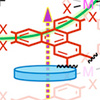| Jun 28, 2023 |
|
(Nanowerk News) A team of Clemson University chemists has constructed a novel two-dimensional electrically conductive metal-organic framework (MOF), a breakthrough that could help advance modern electronics and energy technologies.
|
|
The team’s findings were published in the journal Angewandte Chemie (“Electrically Conductive π-Intercalated Graphitic Metal-Organic Framework Containing Alternate π-Donor/Acceptor Stacks”).
|
|
MOFs are nano-sized architectures, which resemble miniature buildings made of metal ions linked by organic ligands. The structures are mostly hollow and porous with an extraordinary amount of internal surface space. As a result, MOFs can store guest molecules, catalyze chemical reactions and deliver drugs in a controlled manner.
|
|
Certain MOFs can even conduct electricity, making them potential next-generation semiconductors.
|
|
“We need new materials for semiconductors for electronics and energy technologies, and this class of materials has shown great potential,” said Sourav Saha, an associate professor in the Department of Chemistry, who led the study. “These materials (MOFs) are much easier to synthesize, process and tune their electronic and optical properties than traditional inorganic semiconductors.”
|
Biggest obstacle
|
|
The biggest obstacle to gain high framework conductivity is their porosity.
|
|
“That is really challenging to make porous materials electrically conducting because the charges don’t flow through the pores or the empty space,” Saha said. “That is the holy grail. That is the main challenge of the field.”
|
|
Chemists adopt different strategies to make these materials electrically conducting. The charges can flow through chemical bonds or through the narrow gaps between the organic ligands.
|
|
“Typically, most of these MOFs that are electrically conducting have either through-bond or through-space conduction pathways. What we accomplished here was to combine these two pathways into a single 2D material,” he said.
|
More conductivity
|
|
The new MOF has 10- to 15-times higher conductivity than the parent MOF that lacks such efficient out-of-plane conduction pathways.
|
|
“Dr. Saha’s work is helping to deliver on the promise that metal-organic framework materials offer for improving a wide range of technologies, including batteries, solar cells, and chemical and pharmaceutical production. His clever introduction of electric conductivity in these open framework materials is a tour-de-force of molecular design. It is exciting to see these advances emerge from Clemson’s research enterprise,” said Stephen Creager, associate dean and professor of chemistry in the College of Science.
|

